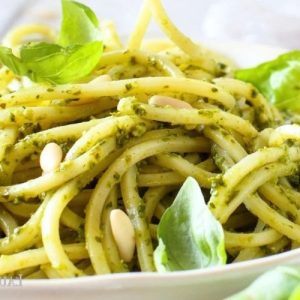
20-Minute Pesto Spaghetti Pasta
This quick and easy Pesto Spaghetti combines tender noodles with a creamy, flavorful basil pesto. Ready in just 20 minutes, it’s a satisfying, fiber-rich, and protein-packed meal perfect for weeknight dinners or effortless meal prep. Serve with a sprinkle of Parmesan for a delicious, family-friendly pasta dish everyone will love.
Equipment
- 1 Large Mixing or Serving Bowl
- 1 large pot (for boiling pasta)
- 1 Pasta Strainer
- 1 Pasta Spoon or Tongs
- Measuring Cups and Spoons
Ingredients
- 16 ounces spaghetti
- 6 ounces pesto about ¾ cup
- 1 cup reserved pasta water
- ⅓ cup Parmesan cheese for serving
Instructions
- Prepare Your Ingredients: Before you turn on the stove, gather all your ingredients and equipment. Measure out 6 ounces of fresh or store-bought pesto and place it in a large mixing or serving bowl. Set aside 16 ounces of spaghetti, ⅓ cup of Parmesan cheese for topping, and a measuring cup for reserving pasta water. Having everything ready ensures a smooth cooking process without any last-minute scrambling.
- Boil the Water: Fill a large pot with water, leaving enough room for the spaghetti to move freely while cooking. Add a generous pinch of salt to enhance the pasta’s flavor. Place the pot on high heat and bring the water to a rolling boil. The water should be bubbling vigorously before adding the pasta, which ensures even cooking and prevents sticking.
- Cook the Spaghetti: Once the water is boiling, gently add the spaghetti, separating the strands as needed to prevent clumping. Cook the pasta according to the package instructions, usually about 8–10 minutes, until it reaches al dente texture—tender but with a slight bite. Stir occasionally during cooking to prevent sticking, and avoid overcooking for the best consistency.
- Reserve Pasta Water: Before draining, scoop out 1 cup of the hot pasta water using a heatproof measuring cup. This starchy water is essential for adjusting the pesto sauce to the perfect consistency, allowing it to coat each strand of spaghetti evenly without drying out.
- Drain the Pasta: Carefully pour the cooked spaghetti into a pasta strainer to drain the water. Shake gently to remove excess liquid but avoid over-draining, as a small amount of moisture helps the sauce cling to the noodles. Immediately transfer the drained pasta into the large bowl containing the pesto to prevent it from sticking or cooling too quickly.
- Combine Pesto and Pasta: Add about half of the reserved pasta water to the bowl with the spaghetti and pesto. Using kitchen tongs or a pasta spoon, gently toss the pasta with the sauce. Work slowly and methodically, ensuring every strand is coated. Gradually add the remaining pasta water in small increments until the sauce reaches your desired creaminess. This step is key to achieving a silky, luscious texture without a watery or clumpy sauce.
- Adjust Seasoning and Texture: Taste a small portion of the coated pasta and adjust as needed. If the sauce feels too thick, add a splash more pasta water; if you want more flavor, sprinkle in a little extra salt or freshly cracked black pepper. This fine-tuning ensures your pesto spaghetti is perfectly balanced and flavorful.
- Plate the Pasta: Use tongs or a pasta fork to neatly twirl portions of spaghetti into individual bowls or plates. Presentation matters, so try to keep the strands together rather than scattered. The vibrant green of the pesto should contrast beautifully against the neutral color of the pasta, making it visually appealing as well as delicious.
- Add Parmesan Topping: Sprinkle ⅓ cup of freshly grated Parmesan cheese over the top of each serving. The cheese melts slightly from the warmth of the pasta, adding a creamy, savory finish. Optionally, you can add a few fresh basil leaves for garnish to enhance both flavor and appearance.
- Serve Immediately: Pesto spaghetti is best enjoyed fresh while warm. Serve immediately to preserve the creamy texture of the sauce and the al dente bite of the pasta. Pair it with a light salad, garlic bread, or a glass of white wine for a complete, satisfying meal. Leftovers can be stored but will slightly thicken once chilled, so reheat gently with a splash of water to restore the silky sauce.
Notes
- Use high-quality pesto for the best flavor; homemade or store-bought works well.
- Reserve pasta water carefully, as it’s key to creating a creamy, clingy sauce.
- Cook spaghetti al dente to prevent mushiness when mixing with the pesto.
- Toss pasta gently to avoid breaking the noodles and to ensure even coating.
- Adjust seasoning at the end; pesto can be salty, so taste before adding extra salt.